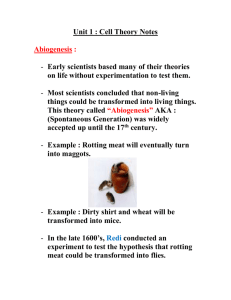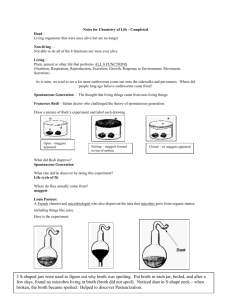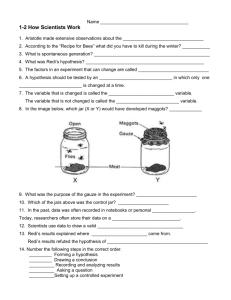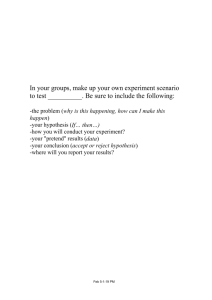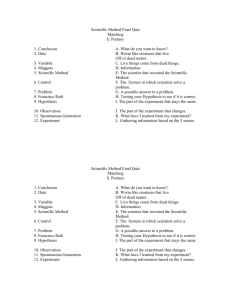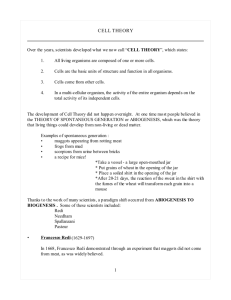scientific method - Warren County Schools
advertisement
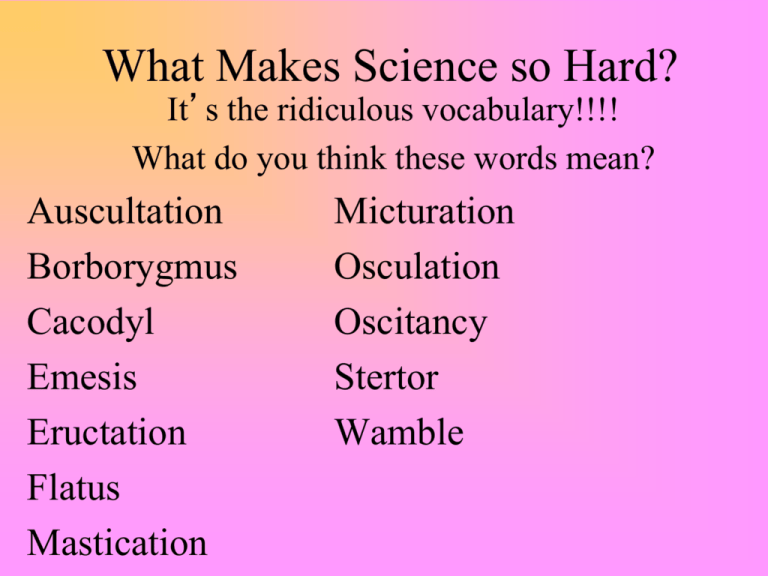
What Makes Science so Hard? It’s the ridiculous vocabulary!!!! What do you think these words mean? Auscultation Borborygmus Cacodyl Emesis Eructation Flatus Mastication Micturation Osculation Oscitancy Stertor Wamble Prefixes & Suffixes • If you learn certain prefixes and suffixes, you can figure out certain words. Don’t let the vocabulary in science bog you down!! You can figure it out. Watch this video and describe what it may have to do with Biology. • http://video.search.yahoo.com/search/video;_ylt= AiLXpPTFzpxzCqWvSZXCemKbvZx4?p=giraffe s+fighting&toggle=1&cop=mss&ei=UTF8&fr=yfp-t-701 • http://video.search.yahoo.com/search/video;_ylt= AiLXpPTFzpxzCqWvSZXCemKbvZx4?p=giraffe s+fighting&toggle=1&cop=mss&ei=UTF8&fr=yfp-t-701 Watch this video and describe what it has to do with Biology. • http://www.youtube.com/watch?v=btuxOC2IzE • http://www.youtube.com/watch?v=md2CW 4qp9e8 Life Science Biology – The study of living things Branches of Biology 1. 2. 3. 4. Ecology – The study of the environment Zoology – The study of animals Doctor – Human anatomy Botany – The study of plants Careers in Biology Global Ecology Marine Biologist Herbatologist Infectious disease DNA and molecular Biology Paleontologist Doctor Earth Science Earth Science(Geology)– The study of the Earth Branches of Earth Science 1. 2. 3. 4. 5. Oceanography – Study of the Ocean Volcanology – Study of volcanoes Seismology – Study of earthquakes Meteorology – Study of the weather Astronomy – Study of space Physical Science Physical Science – Study of both matter and energy Branches of Physical Science 1. 2. 3. 4. Chemistry – The study of all forms of matter Physics – The study of energy Astronomy – Movement of objects in space Oceanography – Study of the waves and tides What is science? How do scientists work? What is Science? Science is an organized way of gathering and analyzing evidence about the natural world. It’s asking questions! I want to teach you this year about the world around. Everyday,I want you to leave here with new knowledge of the world around you !!!! Science Methodology Scientists go about solving problems in a certain way. The methodology is always the same. It is called Scientific Method! STEP 1 - Good Observations Being a good scientists involves making great observations and then asking questions. Several people can observe the same event but have different explanations. This happens in crime scenes all the time. Describe what you observe in this picture. DO NOT discuss it with your neighbors. Observations Leads to Data Collection • Data collection leads to forming an hypothesis. • Two Types of Data 1. Quantative 2. Qualiative There is two types of data researchers can collect: 1. Qualitative data: factual description that do not use numbers. For example, describing the behavior of animals, color of eyes, how mothers react to their young, etc. 2. Quantitative data: factual information that uses number. For example, counting the number of young, measure how tall something grow, etc. Qualitative or Quantitative? Parts of a Controlled Experiment •Constants – all the things you keep the same(same # of plants in a container, same amt of sunlight, same amt of dirt, same amt of fertilizer) *Control Group: The experiment group without the variable being tested. Qualitative or Quantitative? Observations vs. Inferences An OBSERVATION the act of noticing and describing events or processes. You do it with your eyes; when we see something, we observe it. However, all five of our senses can be used to make observations: sight, hearing, taste, touch, and smell. An INFERENCE is an assumption or conclusion based on an observation. It is a logical interpretation based on observations and prior knowledge. Observation Vs. Inferences • When collecting data, as a scientists you must only record your observations and not read anything into what you see. Your inferences are in the conclusion. Name 2 observations and 2 inferences Name 2 observations and 2 inferences The Scientific Method The scientific method is a process for experimentation that is used to explore observations and answer questions. Scientists use the scientific method to search for cause and effect relationships in nature. In other words, they design an experiment so that changes to one item cause something else to change in a predictable way. THE SCIENTIFIC METHOD – a step by step way scientists solve problems. STEP 1: Problem Statement – always written in questions form The scientist then raises a question about what (s)he sees going on!!! Question: How many licks does it take to get to the center of Tootsie roll pop? Research Step 2: Research – background information about the topic. You have to know what you about you topic before you can experiment. Could be notes, books, internet resources, asking an expert, etc. Step 3: Hypothesis – a possible answer to the problem statement. Always written as an IF > THEN statement. If I give 2 cups of water to a tomato plant, then it will grow better than plants given more or less water. This is a tentative answer to the question: a testable explanation for what was observed. IT IS NOT ALWAYS CORRECT! Write a hypothesis for the picture below. Controlled Experiment •Experiment is used to compare an experimental group with a control group to answer a problem •Not all experiments are controlled. You can conduct an experiment without variables. Why is the car not running? You are just solving a problem! * Contains dependent and independent variables. Example – king snake vs. coral snake Procedure – Controlled Experiment Step 4: Procedure – a numbered step set of directions that explains the experimental setup. Includes materials list. Variable – what is being tested, what is different in the experiment (the amount of water given to the plants) Types of Variable in a Controlled Experiment •Independent Variable – The independent variable is the variable that is manipulated by the researcher. *Dependent variable – factors affected by the independent variable. What is the Dependent and Independent Variable? Data and Analysis Step 5: Data and Analysis – explanation of what happened in the experiment. All data collected should be displayed on a data table or on a graph. DATA:factual information gatehred in the experiment.(information or numbers from experiment) What is some data you could collect from these pics? Observations Leads to Data Collection • Data collection leads to forming an hypothesis. • Two Types of Data 1. Quantative 2. Qualiative There is two types of data researchers can collect: 1. Qualitative data: factual description that do not use numbers. For example, describing the behavior of animals, color of eyes, how mothers react to their young, etc. 2. Quantitative data: factual information that uses number. For example, counting the number of young, measure how tall something grow, etc. Qualitative or Quantitative? Parts of a Controlled Experiment •Constants – all the things you keep the same(same # of plants in a container, same amt of sunlight, same amt of dirt, same amt of fertilizer) *Control Group: The experiment group without the variable being tested. Qualitative or Quantitative? Step 6: Conclusion – the answer to the problem statement based on the data you collected. Was the hypothesis correct or not and identify any errors that might have occurred in the experiment. Data and conclusion • Over the next month, you would collect data(height). • Conclusion: at the end of month, see which group grew the best. Scientific Method • 1. Name the steps of the scientific method 2.Explain how to write a hypothesis. 3.Contrast a constant and a control group. 4. Define a variable. 5.Explain why it is important to have a control group 6. Explain how to write a procedure. spontaneous generation Redi, Needham, Spallanzani, and Pasteur Spontaneous Generation • For much of history, people believed that animals could come from non-living sources. They thought: – Frogs developed from falling drops of rain – mice arose from sweaty underwear – and flies arose from decaying meat. • This is called abiogenesis • Also known as spontaneous generation • These ideas were followed because people simply accepted what they were told The Power of Authority • In the past, people believed what they were told by “authorities” such as the Church, or the ancient Greek philosopher Aristotle • Questioning Aristotle was like questioning the Church.... • One “scientist” put forward the belief that mice could be generated spontaneously from wheat and a sweaty shirt. • The wheat provided the “nutritive power” and the shirt provided the “active principle.” • “active principle” = a mysterious “life-force” that allowed spontaneous generation to occur. Francesco Redi - 1668 Italian Physician challenged abiogenesis Hypothesis: If there are maggots present, then they did NOT come from rotting meat. Variables: Open meat vs. not open meat Conclusion: Only maggots on the open meat so maggots came from flies. “The flesh of dead animals cannot engender worms unless the eggs of the living being deposited therein” REDI’S EXPERIMENTS!! • Put dead snakes, eels, and veal in large wide mouthed vessels. Sealed one set with wax and left the other set open to air. • Decaying meat was teeming with maggots, sealed meat had no maggots • Wax sealed vessels failed to produce maggots because flies were unable to reach the meat 1668 -- Francisco Redi (Italian physician & poet)-attempted to disprove the theory of Spontaneous Generation. Redi’s critics said: • You have too many variables • There is a lack of access and a lack of air. • We ALL know that everything needs air. • Of course no flies grew! • You haven’t proven anything. Redi’s Second Experiment • They argued that the flies were coming from the air. • He added a third set of jars that had mesh. • This proved that the flies came from maggots. Redi part 2 – answer to critics fine mesh allows in air, but not flies flies laid eggs on top of mesh no maggots in meat Redi’s Conclusions: • “All living beings come from seeds of the plants or animals themselves” • However, if someone were to demonstrate even one exception to this hypothesis, then Redi’s hypothesis would be rejected. John Needham - 1745 • He believed in abiogenesis(SG). • Hypothesis: If you boiled broth, living organisms still grow from nonliving broth. • Experiment: He boiled broth and bacteria still grew a few days later. John Needham (English Clergyman) wondered if this would work with micro organisms in1745 • Everyone knew that boiling killed organisms. • Needham prepared various broths and showed that they contained microbes. He had a microscope! • Then he boiled them, and showed that there were no longer any microbes. • He ensured the stoppers were loose, so that air would not be excluded • Then, after a few days, microbes had reappeared! • This was “proof” that the microbes had spontaneously generated from the non-living broth. • BUT: how was this evidence of Needham’s error a faulty experiment? – what ERROR in experimental method is shown here? • Hypothesis: microbes MUST HAVE arisen spontaneously from the broth. • Conclusion: there is no other place the microbes could come from (other than the broth). • error: microbes could have come from the air! Lazzaro Spallanzani - 1745 • Italian priest and biologist • Hypothesis: If you boiled the broth hotter, then there would not be any bacteria. • Experiment: He boiled the broth, sealed them. Then boiled again to make sure killed the bacteria. • Conclusion: No spontaneous generation. Spallanzani’s (Italian Naturalist) -- 1745 Disagreed with Needham • • Claimed he didn’t seal jars well enough • He said microbes could have come from the air • He repeated Needham’s experiment, but changed two things: – boiled flasks longer, and – SEALED THEM after boiling by fusing the glass tops shut – (hermetically sealed – absolutely airtight) • Result: NO growth in ANY flask Needham criticizes Spallanzani’s first experiment • BUT Needham said: you boiled it TOO LONG, and: • You spoiled the vegetative power by boiling. • You killed the ability of the broth to give life. • Life can still come from broth -but the broth must not be “damaged” by boiling. Spallanzani’s secondtight experiment seal loose seal • he did TIMED BOILINGS • then left them partially sealed • some partially sealed, some hermetically sealed as in his previous experiment • hypothesized that more boiling should lead to less life • he left some jars as Needham had (leaky seals), to ensure “active principle” was not damaged 30 mins 60 mins 90 mins 120 mins Spallanzani’s second experiment -results tight seal loose seal • this showed TWO main things: • boiling did NOT damage broth’s ability to support life • Conclusion: growth depended on the SEAL only 30 mins 60 mins 90 mins 120 mins Louis Pasteur (French chemist) entered a contest sponsored 1859–by French Academy of Sciences to prove or disprove Spontaneous generation. • used swan-necked flask • flask allowed in air, but trapped dust (and microbes) • boiled infusion • showed that NO growth occurred, even after many days • BUT -- what about damaging the “active principle”? • Pasteur showed that the active principle was NOT damaged • at any later time, he could tip the flask • this allowed nutrient broth to contact the dust • this carried microbes into the broth • result: growth! area where dust had been trapped Pasteur squashes the idea of abiogenesis completely! • Since then, no one has been able to refute Pasteur’s experiment • scientists everywhere soon came to accept that abiogenesis did NOT EXIST. • but: then how did life on this planet start in the first place? Louis Pasteur - 1845 • French Chemist – FINALLY Solved NO abiogenesis! • Hypothesis: If the broth is exposed to air with dust, then there will be more bacteria. • Experiment: Exposed broth to different amounts of dust. • Conclusion: More dust ; more bacteria
